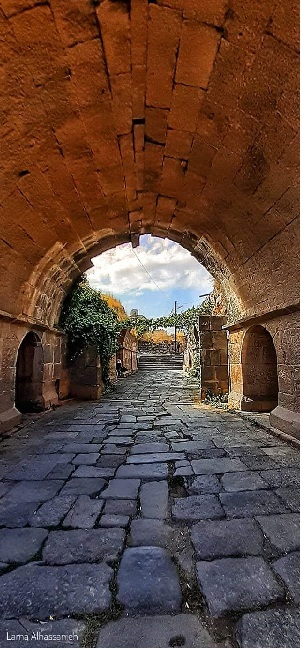Shahba, my mother’s hometown, has always occupied a great part of my heart, despite the fact that I have never lived there. But there is a Syrian saying “The mother gathers”, usually Syrian mothers are very dedicated to gathering the family around them.. Whenever I go to Shahba, I feel like I am in an open-air museum, at every corner you will encounter a Roman column, a banner with Latin inscription, a temple ruin…
Today’s Shahba known in Late Antiquity as Philippopolis (City of Philip), is an ancient city (with a modern district) located 87 km south of Damascus, but was formerly in the Roman province of Arabia Petraea.
Shahba was founded by the Emperor Philip the Arab, who dedicated himself to rebuilding his small native hamlet as a proper colonia between 244 and 249 AD.The city was renamed Philippopolis in dedication to this emperor, who wanted to turn his native city into a replica of Rome herself.
The town’s walls, which follow a typical Roman grid layout, are still recognisable with the four gateways leading into the city. A hexagonal-style temple and an open-air place of worship of local style, called a kalybe, a triumphal arch, baths, a starkly unornamented theatre faced with basalt blocks, a large structure that has been interpreted as a basilica.
 The Philippeion was a particularly elegant building. Eighteen Ionic columns stood on a three-stepped marble base and supported a stone entablature. The roof had marble tiles and a bronze flower on the top.The monument was also used for the worship of the deified royal family.
The Philippeion was a particularly elegant building. Eighteen Ionic columns stood on a three-stepped marble base and supported a stone entablature. The roof had marble tiles and a bronze flower on the top.The monument was also used for the worship of the deified royal family.
The whole city of Shahba was laid out and built following the grid plan of a typical Roman city,however built of black basalt rocks coming from the surrounding regions known for its volcanic landforms.
The main cluster of ruins lies near the centre of the square city and include a forum, a palace, a temple, a medium size theatre, triumphal arch, baths, and a kalybe, which is an open-air place of worship, is a 30 metre niche as part of the façade of the palace, and it is thought that Philip might have sat there on his throne.
The existing community was so small that the city was considered to have been built on virgin soil- possibly the only Roman city to have been built from scratch and not on an existing Arab or Hellenistic settlement, making it the last of the Roman cities founded in the East.
The building of the city, however, was stopped abruptly at Philip the Arab’s death in 249 AD and never finished.
The on-site museum today, was originally a Romanvilla, converted into a museum to preserve the wonderful mosaics in their original location as the villa’s rooms mosaic floors. This exceptionally small museum houses some of the finest classic mosaics found anywhere in the world.
 This town is well worth 2-3 hours of exploration, as a unique experience of being in Rome without going out of Syria, or for foreign tourists “All roads lead to Rome”, a saying derived from medieval Latin. It is noteworthy that you don’t have to miss the following places in Shahba:
This town is well worth 2-3 hours of exploration, as a unique experience of being in Rome without going out of Syria, or for foreign tourists “All roads lead to Rome”, a saying derived from medieval Latin. It is noteworthy that you don’t have to miss the following places in Shahba:
1-ThePhilippieion (the family funerary and worshiping temple)
2-The imperial Palace (Kalippe)
3-The middle size well preserved Roman theatre (can accommodate 2000 people)
4- The large roman baths, which are a relatively large complex compared to the size of this ancient city and are easy to find from the main road near the museum.
5-The town gates that are still visible at the entrance of the town.
The city’s ruins are still well preserved despite the war and it is well worth a stop.
Report & Photography: Lama Alhassanieh

